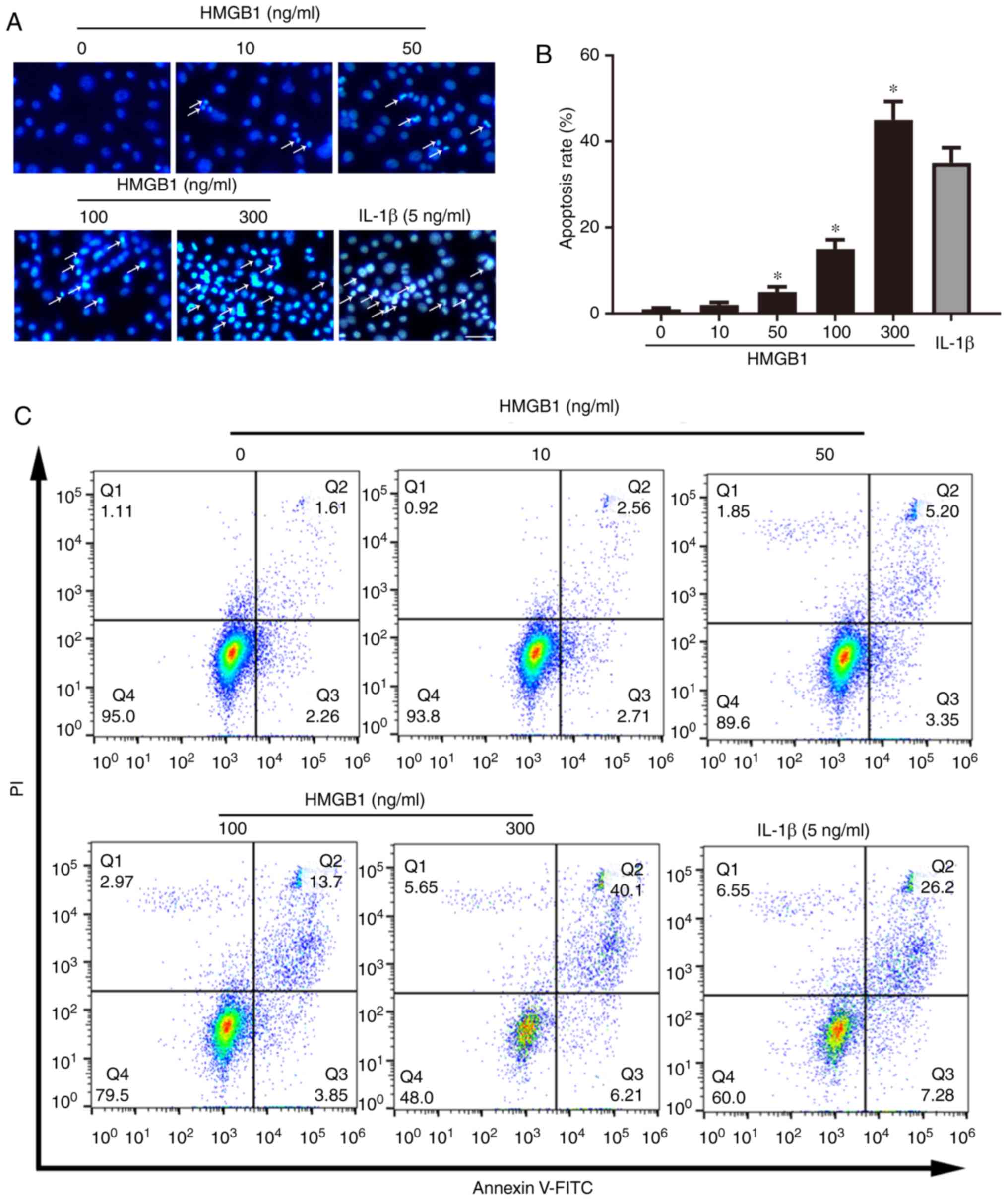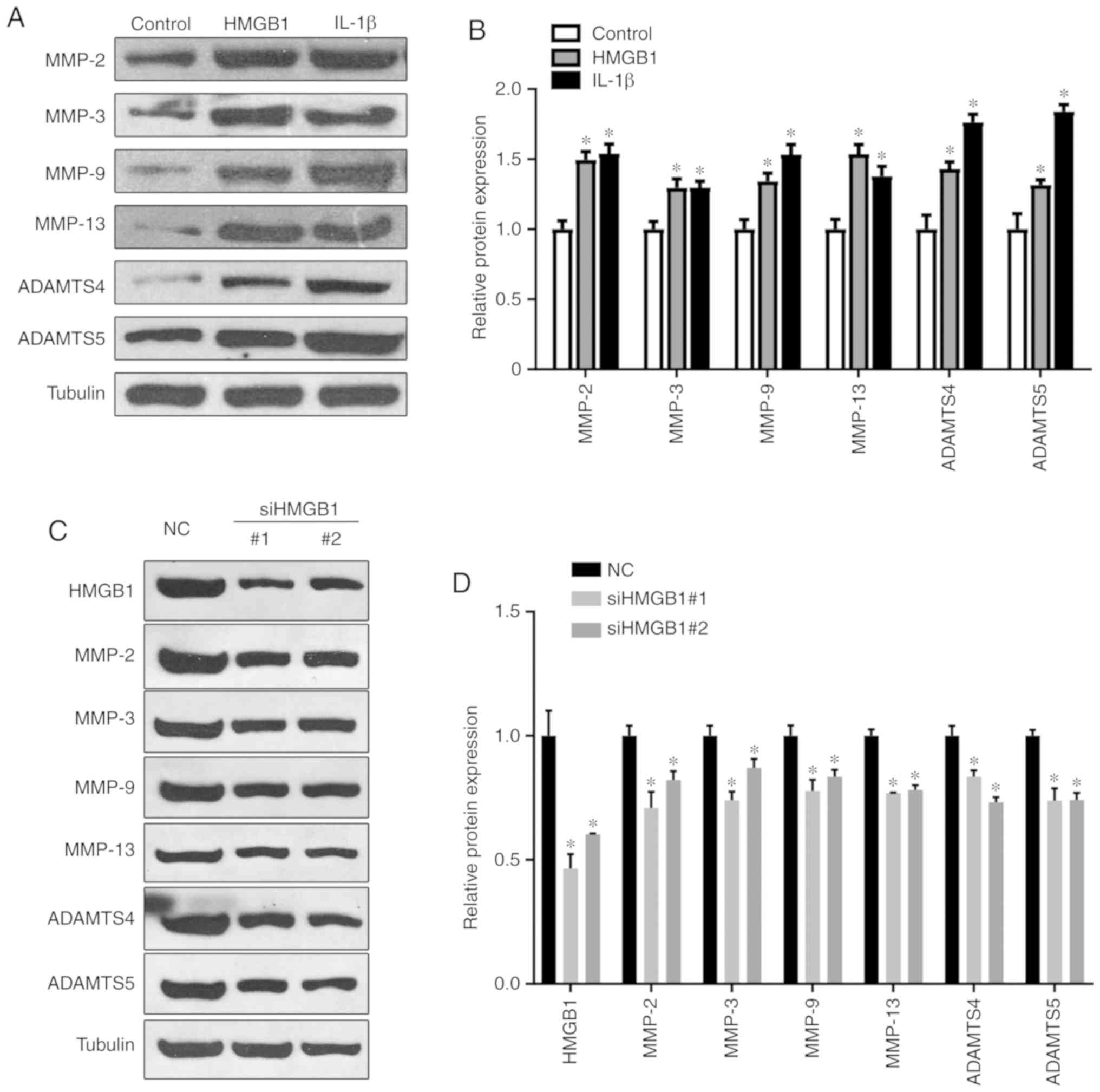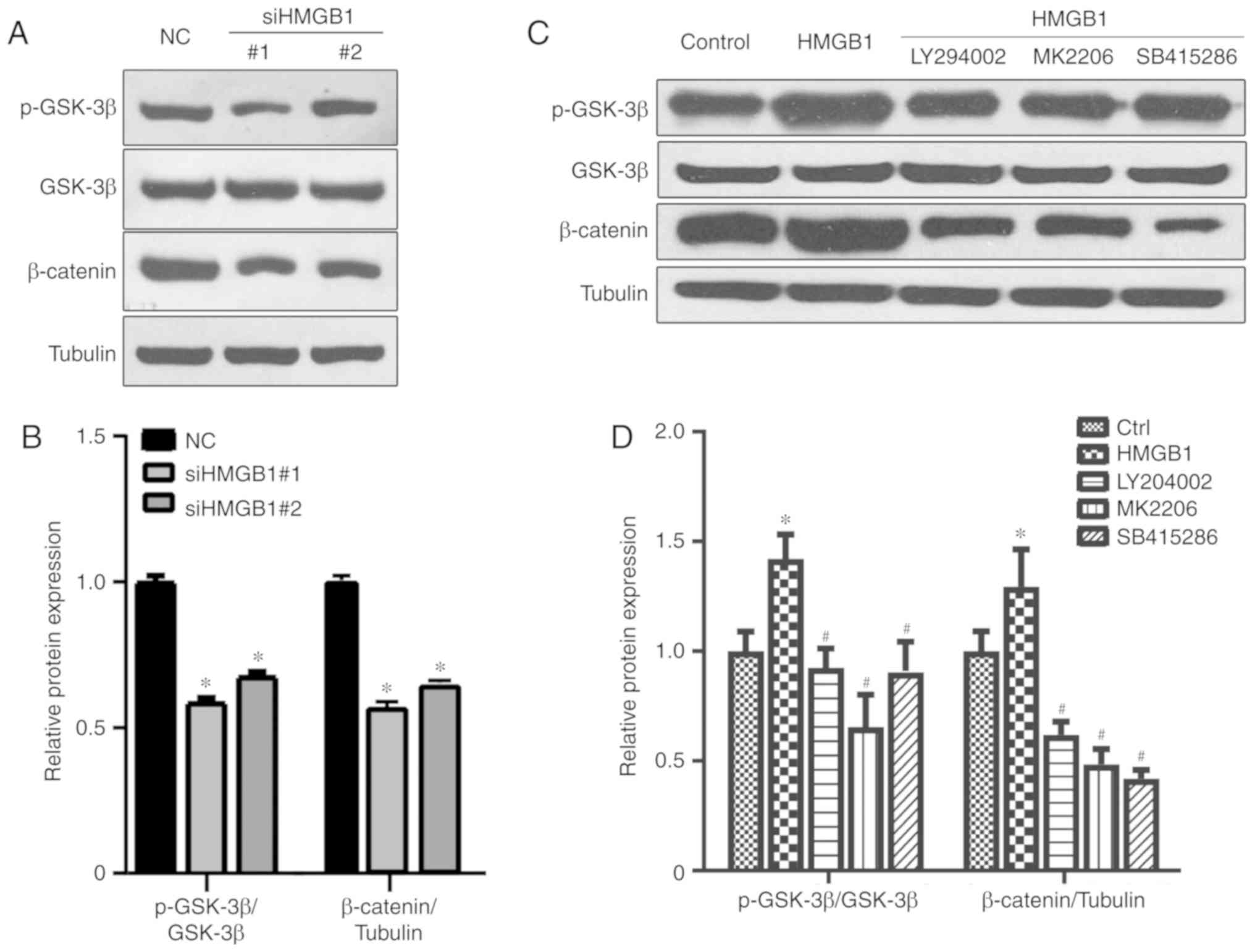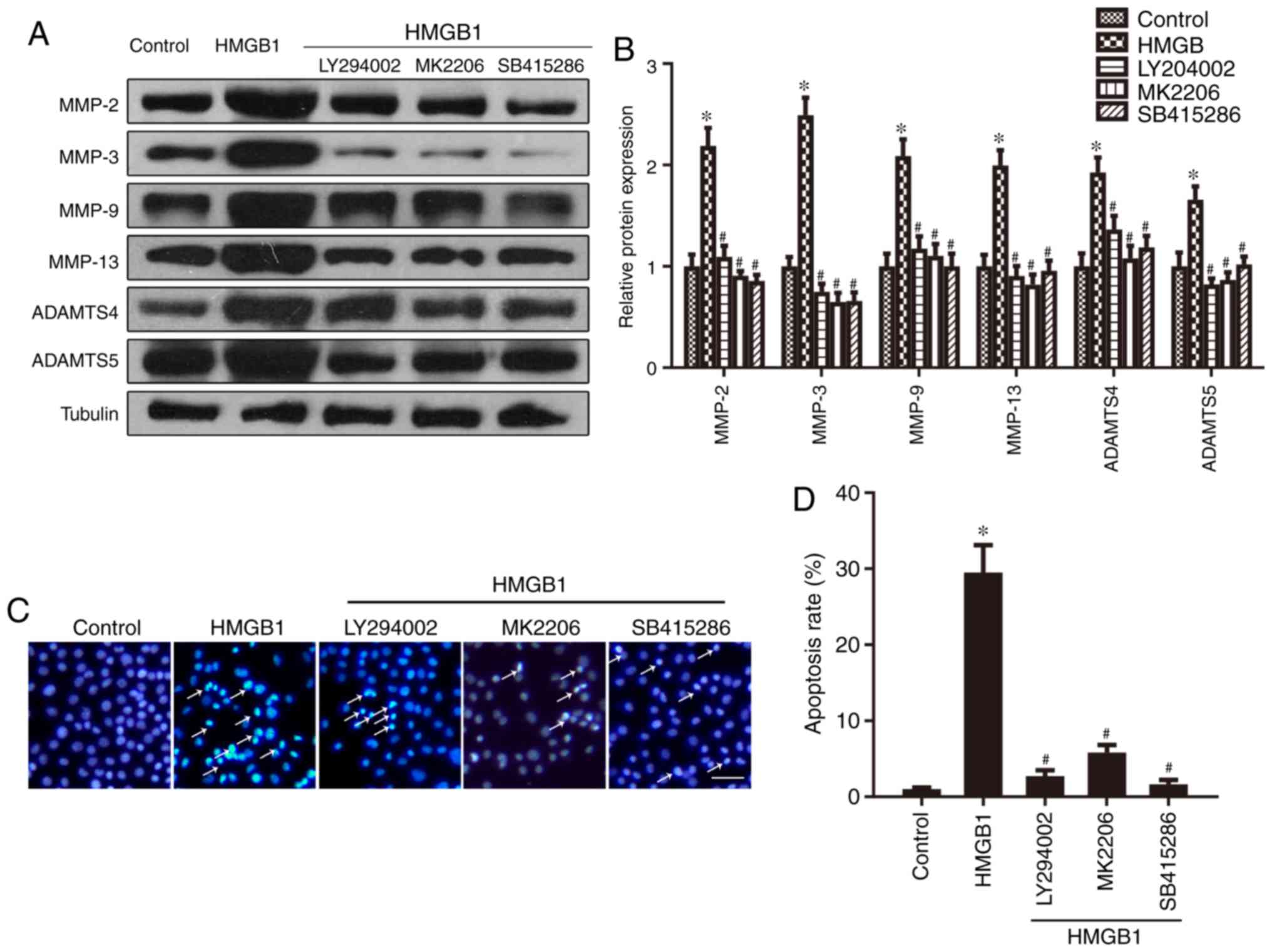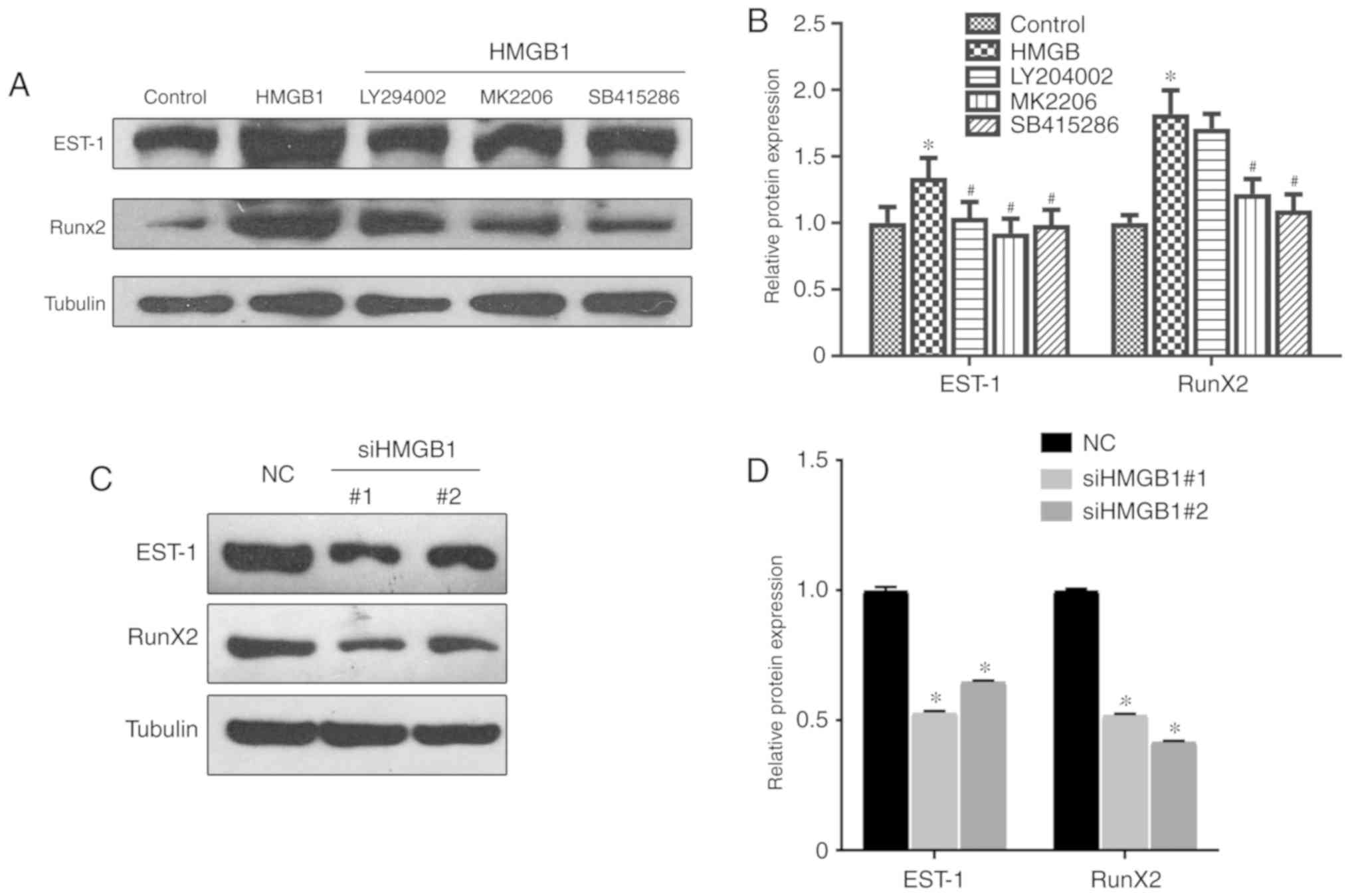|
1
|
Glyn-Jones S, Palmer AJ, Agricola R, Price
AJ, Vincent TL, Weinans H and Carr AJ: Osteoarthritis. Lancet.
386:376–387. 2015. View Article : Google Scholar : PubMed/NCBI
|
|
2
|
Ashford S and Williard J: Osteoarthritis:
A review. Nurse Pract. 39:1–8. 2014. View Article : Google Scholar : PubMed/NCBI
|
|
3
|
Ke X, Jin G, Yang Y, Cao X, Fang R, Feng X
and Lei B: Synovial fluid HMGB-1 levels are associated with
osteoarthritis severity. Clin Lab. 61:809–818. 2015. View Article : Google Scholar : PubMed/NCBI
|
|
4
|
Wang X, Guo Y, Wang C and Yu H, Yu X and
Yu H: MicroRNA-142-3p Inhibits chondrocyte apoptosis and
inflammation in osteoarthritis by targeting HMGB1. Inflammation.
39:1718–1728. 2016. View Article : Google Scholar : PubMed/NCBI
|
|
5
|
Snelling SJ, Davidson RK, Swingler TE, Le
LT, Barter MJ, Culley KL, Price A, Carr AJ and Clark IM: Dickkopf-3
is upregulated in osteoarthritis and has a chondroprotective role.
Osteoarthritis Cartilage. 24:883–891. 2016. View Article : Google Scholar :
|
|
6
|
Ley C, Svala E, Nilton A, Lindahl A,
Eloranta ML, Ekman S and Skiöldebrand E: Effects of high mobility
group box protein-1, interleukin-1β, and interleukin-6 on cartilage
matrix metabolism in three-dimensional equine chondrocyte cultures.
Connective Tissue Res. 52:290–300. 2011. View Article : Google Scholar
|
|
7
|
Puzovic V, Brcic I, Ranogajec I and
Jakic-Razumovic J: Prognostic values of ETS-1, MMP-2 and MMP-9
expression and co-expression in breast cancer patients. Neoplasma.
61:439–446. 2014. View Article : Google Scholar : PubMed/NCBI
|
|
8
|
Yin Y and Wang Y: Association of BMP-14
rs143383 ploymorphism with its susceptibility to osteoarthritis: A
meta-analysis and systematic review according to PRISMA guideline.
Medicine (Baltimore). 96:e74472017. View Article : Google Scholar
|
|
9
|
Zhang RK, Li GW, Zhang DW, Yu B and Feng
SY: Research of the expression of subchondral bone of Indian
hedgehog with early experimental osteoarthritis induced by
mechanical stress. Zhonghua yi xue za zhi (Chinese). 97:53–56.
2017.
|
|
10
|
Xu W, Gao P, Zhang Y, Piao L and Dong D:
microRNA-138 Induces Cell Survival and Reduces WNT/β-catenin
signaling of osteoarthritis chondrocytes through NEK2. IUBMB Life.
71:1355–1366. 2019. View
Article : Google Scholar : PubMed/NCBI
|
|
11
|
Okura T, Ohkawara B, Takegami Y, Ito M,
Masuda A, Seki T, Ishiguro N and Ohno K: Mianserin suppresses
R-spondin 2-induced activation of Wnt/β-catenin signaling in
chondrocytes and prevents cartilage degradation in a rat model of
osteoarthritis. Sci Rep. 9:28082019. View Article : Google Scholar
|
|
12
|
Fernandez-Torres J, Zamudio-Cuevas Y,
Lopez-Reyes A, Garrido-Rodríguez D, Martínez-Flores K, Lozada CA,
Muñóz-Valle JF, Oregon-Romero E and Martínez-Nava GA: Gene-gene
interactions of the Wnt/β-catenin signaling pathway in knee
osteoarthritis. Mol Biol Rep. 45:1089–1098. 2018. View Article : Google Scholar
|
|
13
|
Sanchez-Adams J, Leddy HA, McNulty AL,
O'Conor CJ and Guilak F: The mechanobiology of articular cartilage:
Bearing the burden of osteoarthritis. Curr Rheumatol Rep.
16:4512014. View Article : Google Scholar : PubMed/NCBI
|
|
14
|
Chen YC, Statt S, Wu R, Chang HT, Liao JW,
Wang CN, Shyu WC and Lee CC: High mobility group box 1-induced
epithelial mesenchymal transition in human airway epithelial cells.
Sci Rep. 6:188152016. View Article : Google Scholar : PubMed/NCBI
|
|
15
|
Jiang Y, Zhu L, Zhang T, Lu H, Wang C, Xue
B, Xu X, Liu Y, Cai Z, Sang W, et al: BRD4 has dual effects on the
HMGB1 and NF-κB signalling pathways and is a potential therapeutic
target for osteoarthritis. Biochim Biophys Acta Mol Basis Dis.
1863:3001–3015. 2017. View Article : Google Scholar : PubMed/NCBI
|
|
16
|
Zhang C, Yu W, Huang C, Ding Q, Liang C,
Wang L, Hou Z and Zhang Z: Chrysin protects human osteoarthritis
chondrocytes by inhibiting inflammatory mediator expression via
HMGB1 suppression. Mol Med Rep. 19:1222–1229. 2019.
|
|
17
|
Flemming A, Brummer T, Reth M and Jumaa H:
The adaptor protein SLP-65 acts as a tumor suppressor that limits
pre-B cell expansion. Nat Immunol. 4:38–43. 2003. View Article : Google Scholar
|
|
18
|
Shen C, Cai GQ, Peng JP and Chen XD:
Autophagy protects chondrocytes from glucocorticoids-induced
apoptosis via ROS/Akt/FOXO3 signaling. Osteoarthritis Cartilage.
23:2279–2287. 2015. View Article : Google Scholar : PubMed/NCBI
|
|
19
|
Hui W, Litherland GJ, Jefferson M, Barter
MJ, Elias MS, Cawston TE, Rowan AD and Young DA: Lithium protects
cartilage from cytokine-mediated degradation by reducing
collagen-degrading MMP production via inhibition of the P38
mitogen-activated protein kinase pathway. Rheumatology (Oxford).
49:2043–2053. 2010. View Article : Google Scholar
|
|
20
|
Li Y, Wang XY, Zhang ZL, Cheng X, Li XD,
Chuai M, Lee KK, Kurihara H and Yang X: Excess ROS induced by AAPH
causes myocardial hypertrophy in the developing chick embryo. Int J
Cardiol. 176:62–73. 2014. View Article : Google Scholar : PubMed/NCBI
|
|
21
|
He YQ, Li Y, Wang XY, He XD, Jun L, Chuai
M, Lee KK, Wang J, Wang LJ, Yang X, et al: Dimethyl phenyl
piperazine iodide (DMPP) induces glioma regression by inhibiting
angio-genesis. Exp Cell Res. 320:354–364. 2014. View Article : Google Scholar
|
|
22
|
Yavropoulou MP and Yovos JG: The role of
the Wnt signaling pathway in osteoblast commitment and
differentiation. Hormones (Athens). 6:279–294. 2007. View Article : Google Scholar
|
|
23
|
Iwata M, Aikawa T, Hakozaki T, Arai K,
Ochi H, Haro H, Tagawa M, Asou Y and Hara Y: Enhancement of Runx2
expression is potentially linked to beta-catenin accumulation in
canine intervertebral disc degeneration. J Cell Physiol.
230:180–190. 2015. View Article : Google Scholar
|
|
24
|
Vega OA, Lucero CMJ, Araya HF, Jerez S,
Tapia JC, Antonelli M, Salazar-Onfray F, Las Heras F, Thaler R,
Riester SM, et al: Wnt/β-catenin signaling activates expression of
the bone-related transcription factor RUNX2 in select human
osteosarcoma cell types. J Cell Biochem. 118:3662–3674. 2017.
View Article : Google Scholar : PubMed/NCBI
|
|
25
|
Andersson U and Tracey KJ: HMGB1 is a
therapeutic target for sterile inflammation and infection. Annu Rev
Immunol. 29:139–162. 2011. View Article : Google Scholar : PubMed/NCBI
|
|
26
|
Nalesso G, Sherwood J, Bertrand J, Pap T,
Ramachandran M, De Bari C, Pitzalis C and Dell'accio F: WNT-3A
modulates articular chondrocyte phenotype by activating both
canonical and noncanonical pathways. J Cell Biol. 193:551–564.
2011. View Article : Google Scholar : PubMed/NCBI
|
|
27
|
Park SY, Lee SW, Kim HY, Lee WS, Hong KW
and Kim CD: HMGB1 induces angiogenesis in rheumatoid arthritis via
HIF-1α activation. Eur J Immunol. 45:1216–1227. 2015. View Article : Google Scholar
|
|
28
|
Heinola T, Kouri VP, Clarijs P, Ciferska
H, Sukura A, Salo J and Konttinen YT: High mobility group box-1
(HMGB-1) in osteoarthritic cartilage. Clin Exp Rheumatol.
28:511–518. 2010.PubMed/NCBI
|
|
29
|
Takamatsu A, Ohkawara B, Ito M, Masuda A,
Sakai T, Ishiguro N and Ohno K: Verapamil protects against
cartilage degradation in osteoarthritis by inhibiting Wnt/β-catenin
signaling. PLoS One. 9:e926992014. View Article : Google Scholar
|
|
30
|
Yuan Z, Luo G, Li X, Chen J, Wu J and Peng
Y: PPARgamma inhibits HMGB1 expression through upregulation of
miR-142-3p in vitro and in vivo. Cell Signal. 28:158–164. 2016.
View Article : Google Scholar : PubMed/NCBI
|
|
31
|
Gardella S, Andrei C, Ferrera D, Lotti LV,
Torrisi MR, Bianchi ME and Rubartelli A: The nuclear protein HMGB1
is secreted by monocytes via a non-classical, vesicle-mediated
secretory pathway. Embo Rep. 3:995–1001. 2002. View Article : Google Scholar : PubMed/NCBI
|
|
32
|
Garcia-Arnandis I, Guillen MI, Gomar F,
Pelletier JP, Martel-Pelletier J and Alcaraz MJ: High mobility
group box 1 potentiates the pro-inflammatory effects of
interleukin-1β in osteoarthritic synoviocytes. Arthrit Res Ther.
12:R1652010. View
Article : Google Scholar
|
|
33
|
Garcia-Arnandis I, Guillen MI, Castejon
MA, Gomar F and Alcaraz MJ: Haem oxygenase-1 down-regulates high
mobility group box 1 and matrix metalloproteinases in
osteoarthritic synoviocytes. Rheumatology (Oxford). 49:854–861.
2010. View Article : Google Scholar
|
|
34
|
Ghosh S, Basu M and Roy SS: ETS-1 protein
regulates vascular endothelial growth factor-induced matrix
metalloproteinase-9 and matrix metalloproteinase-13 expression in
human ovarian carcinoma cell line SKOV-3. J Biol Chem.
287:15001–15015. 2012. View Article : Google Scholar : PubMed/NCBI
|
|
35
|
Ji Q, Xu X, Xu Y, Fan Z, Kang L, Li L,
Liang Y, Guo J, Hong T, Li Z, et al: miR-105/Runx2 axis mediates
FGF2-induced ADAMTS expression in osteoarthritis cartilage. J Mol
Med (Berl). 94:681–694. 2016. View Article : Google Scholar
|
|
36
|
Mekala LP, Mohammed M, Chintalapati S and
Chintalapati VR: Stable isotope-assisted metabolic profiling
reveals growth mode dependent differential metabolism and multiple
catabolic pathways of l-phenylalanine in rubrivivax benzoatilyticus
JA2. J Proteome Res. 17:189–202. 2018. View Article : Google Scholar
|
|
37
|
Dell'Isola A, Allan R, Smith SL, Marreiros
SS and Steultjens M: Identification of clinical phenotypes in knee
osteoarthritis: A systematic review of the literature. BMC
Musculoskelet Disord. 17:4252016. View Article : Google Scholar : PubMed/NCBI
|
|
38
|
Arend WP and Dayer JM: Inhibition of the
production and effects of interleukin-1 and tumor necrosis factor
alpha in rheumatoid arthritis. Arthritis Rheum. 38:151–160. 1995.
View Article : Google Scholar : PubMed/NCBI
|
|
39
|
Nagase H and Woessner JF Jr: Matrix
metalloproteinases. J Biol Chem. 274:21491–21494. 1999. View Article : Google Scholar : PubMed/NCBI
|
|
40
|
Loeser RF, Yammani RR, Carlson CS, Chen H,
Cole A, Im HJ, Bursch LS and Yan SD: Articular chondrocytes express
the receptor for advanced glycation end products: Potential role in
osteoarthritis. Arthritis Rheum. 52:2376–2385. 2005. View Article : Google Scholar : PubMed/NCBI
|
|
41
|
Schulte G and Bryja V: WNT signalling:
Mechanisms and therapeutic opportunities. Br J Pharmacol.
174:4543–4546. 2017. View Article : Google Scholar : PubMed/NCBI
|
|
42
|
Xia C, Wang P, Fang L, Ge Q, Zou Z, Dong
R, Zhang P, Shi Z, Xu R, Zhang L, et al: Activation of β-catenin in
Col2-expressing chondrocytes leads to osteoarthritis-like defects
in hip joint. J Cell Physiol. 234:18535–18543. 2019.PubMed/NCBI
|
|
43
|
Nishimura R, Hata K and Kida J: Regulation
of osteoblasts and chondrocytes by Wnt signaling. Clin Calcium
(Japanese). 29:299–307. 2019.
|
|
44
|
Ma L, Liu Y, Zhao X, Li P and Jin Q:
Rapamycin attenuates articular cartilage degeneration by inhibiting
β-catenin in a murine model of osteoarthritis. Connect Tissue Res.
60:452–462. 2019. View Article : Google Scholar : PubMed/NCBI
|
|
45
|
Chen Y, Hu Y, Yang L, Zhou J, Tang Y,
Zheng L and Qin P: Runx2 alleviates high glucose-suppressed
osteogenic differentiation via PI3K/AKT/GSK3 β/β-catenin pathway.
Cell Biol Int. 41:822–832. 2017. View Article : Google Scholar : PubMed/NCBI
|
|
46
|
Deng L, Hu G, Jin L, Wang C and Niu H:
Involvement of microRNA-23b in TNF-α-reduced BMSC osteogenic
differentiation via targeting runx2. J Bone Miner Metab.
36:648–660. 2018. View Article : Google Scholar
|
|
47
|
Cai T, Sun D, Duan Y, Wen P, Dai C, Yang J
and He W: WNT/β-catenin signaling promotes VSMCs to osteogenic
trans-differentiation and calcification through directly modulating
Runx2 gene expression. Exp Cell Res. 345:206–217. 2016. View Article : Google Scholar : PubMed/NCBI
|
|
48
|
Zhu YL, Wang S, Ding DG, Xu L and Zhu HT:
miR217 inhibits osteogenic differentiation of rat bone
marrowderived mesenchymal stem cells by binding to Runx2. Mol Med
Rep. 15:3271–3277. 2017. View Article : Google Scholar : PubMed/NCBI
|
|
49
|
Zhai KF, Duan H, Khan GJ, Xu H, Han FK,
Cao WG, Gao GZ, Shan LL and Wei ZJ: Salicin from alangium chinense
ameliorates rheumatoid arthritis by modulating the Nrf2-HO-1-ROS
pathways. J Agric Food Chem. 66:6073–6082. 2018. View Article : Google Scholar : PubMed/NCBI
|
|
50
|
Zhai KF, Duan H, Cao WG, Gao GZ, Shan LL,
Fang XM and Zhao L: Protective effect of Rabdosia amethystoides
(Benth) Hara extract on acute liver injury induced by Concanavalin
A in mice through inhibition of TLR4-NF-κB signaling pathway. J
Pharmacol Sci. 130:94–100. 2016. View Article : Google Scholar : PubMed/NCBI
|
|
51
|
Zhai KF, Duan H, Luo L, Cao WG, Han FK,
Shan LL and Fang XM: Protective effects of paeonol on inflammatory
response in IL-β-induced human fibroblast-like synoviocytes and
rheumatoid arthritis progression via modulating NF-kappaB pathway.
Inflammopharmacology. Aug 10–2017.Epub ahead of print. View Article : Google Scholar
|
|
52
|
Zhai KF, Duan H, Chen Y, Khan GJ, Cao WG,
Gao GZ, Shan LL and Wei ZJ: Apoptosis effects of imperatorin on
synoviocytes in rheumatoid arthritis through
mitochondrial/caspase-mediated pathways. Food Funct. 9:2070–2079.
2018. View Article : Google Scholar : PubMed/NCBI
|
|
53
|
Zhai KF, Duan H, Cui CY, Cao YY, Si JL,
Yang HJ, Wang YC, Cao WG, Gao GZ and Wei ZJ: Liquiritin from
Glycyrrhiza uralensis attenuating rheumatoid arthritis via reducing
inflammation, suppressing angiogenesis, and inhibiting MAPK
signaling pathway. J Agric Food Chem. 67:2856–2864. 2019.
View Article : Google Scholar : PubMed/NCBI
|















